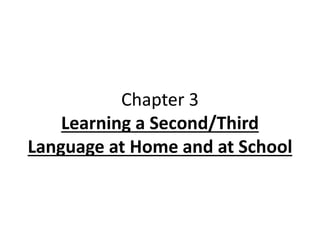
Learning a Second Language at Home and at School
- 1. Chapter 3 Learning a Second/Third Language at Home and at School
- 2. What is bilingualism? Having or using two languages especially as spoken with the fluency characteristic of a native speaker. Possessing a minimal competence in only one of the four language skills in a language other than the mother tongue. The ability to speak a second language while following the concepts and structures of it rather than paraphrasing your mother tongue.
- 3. Code-mixing VS Code-switching All cases where lexical items and grammatical features from two languages appear in one sentence. The first two years is the phase of mixing the languages. Switching from one language to the other according to appropriate changes in speech situation. On the age of three, they start to separate the two languages and to address people in different languages depending on their relevant language background.
- 4. Early Bilingualism • The 'simultaneous acquisition' is the process of the earliest chance of learning two languages or more. It starts at birth. • Bilingual children generally appear to develop more slowly in linguistic terms. They may say their first words a little later and learn fewer words and grammatical structures.
- 5. Early Bilingualism • Bilingual children are more aware to language systems as bilingualism helps in Meta-linguistic awareness, the ability to reflect on and manipulate the structural features of language. They are also more conscious of language structures and patterns and learn to reflect on these earlier.
- 6. The critical Period Hypothesis (CPH) • Psycholinguists suggest that brain flexibility was only helpful to language learning until puberty. In terms of language acquisition, it is suggested that children who start acquiring younger than 11-12 years of age have a plenty of input and interaction in the second language environment.
- 7. Younger VS older learners • Children are sensitive to the sounds and the rhythm of new languages. They enjoy copying new sounds and patterns of intonation. Younger learners are less anxious and less inhibited and they can spend more time devoted to the language compared with those who start later.
- 8. Younger VS older learners • On the other hand, older learners use more efficient strategies, have more mature conceptual world to rely on, have a clearer sense of discourse and have a clearer sense of why they are learning a new language. Older learners are more analytical and give attention to detail.
- 9. Learning a Second Language in the Playground and at School • Familiar routines and games offer great opportunities for hearing the same language again and again and learning to take part in simple conversations. • In case of school language, it takes much longer to catch up with the academic language skills necessary to participate in school discourse.
- 10. What About the Native Language? • developing child's mother tongue and his second language literacy skills in parallel is essential. WHY?
- 11. How Do Children Learn a Second Language? • there are two ways in which children may learn a second language: simultaneously or sequentially:
- 12. Simultaneous Second Language Learning • include children under the age of 3 who are exposed to two languages at the same time. • Before 6 months of age children learn both languages at similar rates and do not prefer one language over the other as they build separate but equally strong language systems in their brains for each language they hear. These separate systems allow children to learn more than one language without becoming confused. • At 6 months, children begin to notice differences between languages and may begin to prefer the language they hear more.
- 13. Sequential Second Language Learners • Include children who have become familiar with one language, but are then introduced or required to learn a second language. • It can occur at any age.
- 14. The Four Stages of Sequential Second Language Learning 1- Home Language Use. 2-Silent Period. 3-Telegraphic & Formulaic Speech. 4-Productive Language.
